
Information of Road Pavement
Roads play a vital role in the overall economic development of the country, and the pavements, an essential part of the road, have a significant pavement meaning in civil engineering So that it is important that the road pavements should be well designed and constructed so that they can allow the heavy movement of traffic through them.
Various factors can degrade the road pavement such as climatic conditions, frequency of usage, and the weight of the vehicular traffic.
Here In this article, we will explore the whole concept of the road pavement and the types of road pavements and the road construction layers in detail so that you will have a clear picture of the structure of the road pavement.
What Is Road Pavement?

A road pavement is defined as a layered structure that is supported by the subgrade soil to form a carriageway of a road is known as road pavement. It is a type of hard surface that is made from durable surface materials that are laid down to carry a heavy load of vehicular traffic.
The main purpose of the road pavement is to uniformly distribute the load imposed on the road by the vehicular traffic to the underlying layers of the soil.
The road pavement should possess High load-bearing capacity, skid resistance, and strength and durability for the smooth movement of the vehicles.
The road pavement is constructed with various layers that are started from the bottom of the road with subgrade up to the topmost layer that is wearing course.
Purpose of Road Pavements
There are various purposes of the road pavement which are as follows.
- The main purpose of the road pavement is to carry the heavy loads of the vehicular traffic and transfer them to the subsoil strata.
- To prevent ill effects of weathering agencies on the sub-grade soil.
- To provide a smooth surface for the movement of vehicles.
- To distribute the load over a large area on the underlying soil strata.
Applications of Road Pavements
The road pavement shave wide applications which are as follows
- The road pavements are constructed to transmits the heavy load of the movement of vehicular traffic.
- It provides smooth surface for the movement of the traffic.
- It does not allow rainwater to accumulate on the surface.
- Road pavements helps in the effective transportation of the vehicles.
Requirement of an Ideal Pavement

The following are the requirement that an ideal pavement should fulfill which are as follows
- The pavement of the road should have a sufficient thickness so that it can properly distribute stresses into the subgrade soil which are generated due to heavy loads of moving vehicles.
- The road pavement should be more durable and required less maintenance.
- It should be structurally strong and stable so that it can efficiently take the loads without failure that are imposed on it.
- The road pavement should have an adequate coefficient of friction to prevent the skidding of the vehicles.
- The road pavement should be smooth enough to provide comfort to the drivers even at the high speed.
- The pavement should have resistance to water absorption and have very little porosity so that the subgrade layers of the soil will be protected and prevent settlement of road pavement.
- The road pavement should be dustproof and ensure that there will be less generation of noise when vehicles are moving from the surface of the road pavement.
- The road pavement should be economical and easy to construct.
- It should have good visibility at night at riding from the road surface should be smooth and comfortable.
- The road pavement should be suitable for all types of traffic and it should not develop any corrugations.
Types of Pavements (Road Pavement)
The pavement types of road pavements are mainly classified into two basic categories: Flexible pavement road and Rigid highway pavement.
- Flexible pavement
- Rigid pavement
1. Flexible Pavements
Flexible pavements, a prime example of what is pavement in road construction, are the type of road pavement that can adapt their shape to some extent without rupture.
In the case of the flexible pavement, the loads that are generated by the movement of vehicles are transferred to the subgrade soil. The load is transferred to the subgrade by grain to grain through the point of contact between the granular structure.
The common examples of flexible pavements are bituminous roads, water-bound macadam pavements, and gravel pavement. Flexible pavements have less flexural strength.
The design of the flexible pavement is based on the concept of the layered system in which the total load acting on the pavement is a transfer from grain to grain to the underneath strata.
Types of Flexible Pavements
The flexible pavement is classified into subtypes which are as follows
- Conventional layered flexible pavement
- Full-depth asphalt pavement, and
- Contained rock asphalt mat (CRAM).
a. Conventional Layered Flexible Pavement
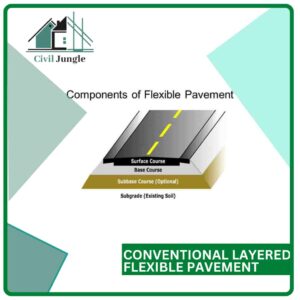
The conventional layered flexible pavement is constructed in a layered system that consists of subgrade which is the bottom-most layer of the pavement, subbase, base course, and base coat, etc.
During the construction of the conventional layered flexible pavement, the high-quality materials are placed at the topmost part of the pavement and the low-quality materials are placed at the bottom layers.
b. Full-Depth Asphalt Pavement

The Full-depth asphalt pavement is a type of flexible pavement in which the bituminous layer is directly constructed on the subgrade layer. This type of layer is suitable when there is no availability of the material and the construction cost of the project is low.
c. Contained Rock Asphalt Mat

The contained rock asphalt mat is constructed by placing the dense and open-graded aggregates layers between the two layers of the asphalt.
The asphalt concrete layer is designed and laid over the subgrade. The asphalt concrete will reduce the compressive strain on the subgrade layers and also protects water. The asphalt layer acts as a barrier to restrict the entry of water into the subgrade layers of the pavement.
Advantages of Flexible Road Pavements
The advantages of the flexible road pavements are as follows
- The cost of construction required for the flexible pavement is low.
- The repairs required for the flexible pavements are easy and fast.
- The materials required for the construction of the flexible road pavements are easy.
- Flexible road pavements resist the formation of the ice glaze.
Disadvantages of Flexible Road Pavements
There are also some disadvantages of the flexible road pavements that are as follows
- The flexible road pavements required regular maintenance.
- The flexible road pavements have less lifespan.
- It has weak edges due to which it requires curb structures.
- The flexible road pavements required regular maintenance.
2. Rigid Pavements
The road pavement that cannot alter its shape without rupture is known as the Rigid pavement, clearly illustrating the pavement definition. The rigid pavements are more capable to transfer the heavy loads of vehicular traffic to the wider area.
The cement concrete pavement is an example of rigid pavement. The cement concrete road pavement has good flexural strength. The rigid pavements can be directly constructed over the compacted subgrade or granular layer.
The rigid pavements have high compressive strength due to which they are more suitable for the movement of heavy load traffic. The rigid pavements also required less maintenance.
Types of Rigid Pavements
The rigid pavements are mainly classified into four types:
- Jointed plain concrete pavement (JPCP)
- Jointed reinforced concrete pavement (JRCP)
- Continuous reinforced concrete pavement (CRCP)
- Pre-stressed concrete pavement (PCP)
a. Jointed Plain Concrete Pavement
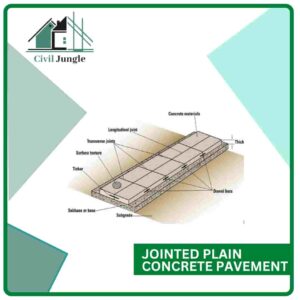
The jointed plain concrete pavement is a type of rigid pavement that is constructed using plain cement concrete with closely spaced contraction joints. The steel bars are used for transferring loads across the joints.
b. Jointed Reinforced Concrete Road

The purpose of providing dowel bars is to transfer the loads only and the reinforcement which is used in the slab helps to keep the road pavement together. The reinforcement does not increase the structural stability of the road.
c. Continuous Reinforced Concrete Road

In the continuous reinforced concrete road pavement, there are no joints are provided. These reinforcements are provided in the continuous reinforced concrete road pavement.
d. Pre-Stressed Concrete Pavement
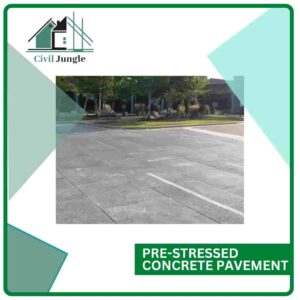
In the pre-stressed concrete road pavements, the stresses are induced to increase its properties so that it can sustain heavy loads which are caused by the movement of the vehicular traffic.
Advantages of Rigid Road Pavements
There are numerous advantages of the road pavement which are as follows
- Rigid Road pavement provides a strong leveled surface for the movement of vehicles.
- Road pavements have good visibility at night.
- There will not any corrugations are developed in the rigid road pavements.
- Rigid road pavements are more durable and can be directly constructed over the subgrade.
- They have a high load-bearing capacity and require less maintenance.
- Rigid road pavement provides a strong, durable, and impermeable surface for the movement of traffic.
Disadvantages of Rigid Road Pavements
There are also some disadvantages of the rigid road pavements which are as follows
- The initial cost required for the construction of rigid road pavement is high.
- The rigid road pavements are little bit noise under iron-tired traffic.
- They require high skilled supervision and labor.
- The rigid pavement cannot be quickly opened for the movement of the traffic.
- The rigid road pavements may undergo cracks due to the variation in the temperature.
Road Construction Layers (With Full Detail)
The following are the layers of the pavement that are laid during the construction of roads:
- Compacted subgrade layer
- Sub-base course
- Basecourse or foundation course
- Basecoat or intermediate course
- Binder coat
- Tack coat
- Wearing course
a. Compacted Subgrade Layer
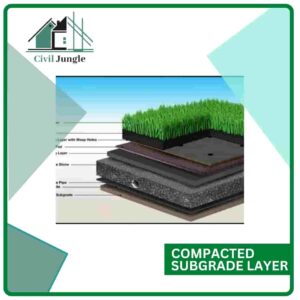
The subgrade layer of the pavement of the rad is the finished and compacted surface of the earthwork above which the pavement of the road rests.
The thickness of the subgrade layer generally ranges from 150 mm to 300 mm. The compacted subgrade layer of the pavement acts as a base for all the above layers and all the stresses are transferred to the subgrade layer of the pavement.
The compacted subgrade layer should be properly compacted with the optimum moisture content because this layer of the road pavement carries the entire load.
Function of Compacted Subgrade Layer.
- To provide support to the road pavement.
- The subgrade layer is responsible to carry the total load acting on the road pavement.
- It acts as a foundation for the road pavement.
b. Sub Base
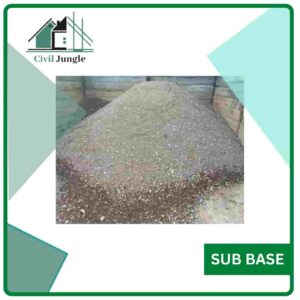
The sub-base course of the road pavement is a layer of granular material that is constructed between the subgrade layer and the base course. The sub-base course is constructed to provide structural support and also improve the drainage property.
The sub-base course layer thickness ranges from 100 mm to 300 mm. This layer is also known as a granular sub-base because it is constructed with various granular materials.
Functions of the Sub Base.
- The sub-base improves the bearing capacity of the subgrade.
- It also improves the drainage property of the sub-base course.
- It keeps the check on the capillary rise of the subsoil water.
c. Base Course
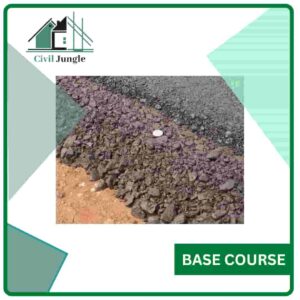
A base course is a layer of boulders or bricks provided in a durable layer over the sub-base or immediately over the subgrade layer in the absence of the sub-base in road pavement.
The thickness of the base course ranges between 100 mm to 300 mm. The different types of materials are used for the construction of the base course such as crushed stones and slags, and other types of stabilized materials.
The sub-base course provides sub-surface drainage and load distribution to the pavement of the road. It helps to resists the shear stress that is developed due to the movement of the vehicles on the road surface.
There are various types of base course layers that are provided in the road pavement which are granular base course, macadam base course, etc.
Functions of the Base Course
- The base course also acts as a foundation that helps to transfer the load to the underneath strata through the subgrade layer.
- The base course is provided to withstand the high shearing stresses which are developed due to the movement of the traffic.
d. Basecoat

In the base coat course, the layer of the hard stones is provided between the base course and the wearing course in a road pavement is called a base coat. This layer of the road pavement is also known as the Intermediate course or bearing course.
Functions of the Base Coat
- The main function of the base coat is to transmit the total load over the larger area of the base course.
- It also acts as a transmission material.
e. Binder Coat

The binder coat is a layer in the road pavement that mainly consists of the aggregate that is mixed with the low asphalt and does not require high quality. The range of thickness of the binder coat varies from 50 mm to 100 mm.
f. Tack Coat

Tack coat consists of the very little amount of asphalt that is applied to the surface of the layer. The main function of the tack coat is to provide a proper bonding between the two layers of the binder course. The function of the tack coat is to uniformly cover the entire surface of the pavement.
g. Wearing Course

The topmost layer of the road pavement that is directly exposed to the traffic is known as the wearing course or surface course. It is the main topmost layer that is responsible to carry the direct traffic load.
The range of the thickness of the wearing course is between 25 mm to 50 mm. It is necessary that the wearing course should be constructed with high-quality materials.
The function of the wearing course is to provide the impervious layers to avoid the entry of water to the base course and effectively distribute the load over the sub-base.
Conclusion of Road Pavement
In India, flexible road pavements, often referred to as what is a pavement in the context of Indian road construction, are more commonly constructed due to their lower cost and the availability of the local materials that are required for the construction of flexible pavements.
The rigid pavement is mostly constructed for the national highways and expressways and it is generally used in the metro-Politian cities.
FAQ on Road Pavements
What Is Road Pavement?
Road pavement is a layered structure supported by the subgrade soil that forms the carriageway of a road. It is designed to support heavy vehicular traffic and uniformly distribute the load to the underlying soil layers.
What Are the Main Purposes of Road Pavements?
The main purposes of road pavements are to:
- Carry heavy loads of vehicular traffic and transfer them to the subsoil.
- Prevent adverse effects of weathering on the sub-grade soil.
- Provide a smooth surface for vehicle movement.
- Distribute loads over a larger area of the underlying soil strata.
What Are the Different Types of Road Pavements?
Road pavements are classified into two main types:
- Flexible Pavements: These adapt their shape to some extent and include bituminous roads, water-bound macadam pavements, and gravel pavements.
- Rigid Pavements: These do not alter their shape and include cement concrete pavements.
What Are the Key Requirements of an Ideal Road Pavement?
An ideal road pavement should:
- Have sufficient thickness to distribute stresses properly.
- Be durable with minimal maintenance needs.
- Be structurally strong and stable.
- Provide adequate friction to prevent skidding.
- Be smooth for driver comfort.
- Resist water absorption and be dustproof.
- Be economical and suitable for various traffic types.
What Are the Main Construction Layers of a Road Pavement?
The main construction layers of a road pavement are:
- Compacted Subgrade Layer: The foundation of the road.
- Sub-base Course: A granular layer providing structural support and improved drainage.
- Base Course: Provides sub-surface drainage and load distribution.
- Basecoat: Also known as the intermediate or bearing course.
- Binder Coat: Contains aggregate mixed with asphalt to bind layers.
- Tack Coat: Ensures proper bonding between layers.
- Wearing Course: The topmost layer exposed to traffic.
What Are the Advantages and Disadvantages of Flexible Pavements?
Advantages:
- Lower construction cost.
- Easier and faster repairs.
- Materials are readily available.
- Resists ice glaze formation.
Disadvantages:
- Requires regular maintenance.
- Shorter lifespan compared to rigid pavements.
- Weaker edges that need curb structures.
What Are the Advantages and Disadvantages of Rigid Pavements?
Advantages:
- Provides a strong, leveled surface with high load-bearing capacity.
- Requires less maintenance.
- Durable and can be constructed directly over the subgrade.
Disadvantages:
- Higher initial construction cost.
- Can be noisy under iron-tired traffic.
- Requires skilled supervision and labor.
- May crack due to temperature variations.
Where Are Flexible and Rigid Pavements Commonly Used?
In India, flexible pavements are commonly used due to their lower cost and availability of local materials. Rigid pavements are typically used for national highways, expressways, and in metropolitan areas.

